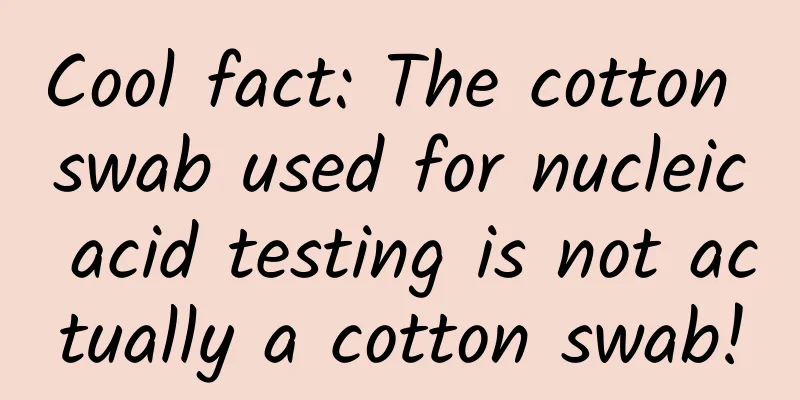Cool fact: The cotton swab used for nucleic acid testing is not actually a cotton swab!

|
Audit expert: Gu Haitong Deputy Chief Physician, Department of Respiratory Medicine, Beijing Tongren Hospital, Capital Medical University Since the normalization of COVID-19 prevention and control, nucleic acid testing has become closely related to our lives. Nucleic acid screening has been done many times, but did you know that what is inserted into the mouth is not the "cotton swab" we think it is? Cotton swab Source | A shopping website Strictly speaking, this cotton-swab-like object is called a "nucleic acid sampling swab", and its top is a flocked swab . When sampling, millions of tiny fibers evenly distributed vertically on it act like a toothbrush to brush a small amount of cells on the posterior pharyngeal wall in our mouth. After completing this step, the sampling swab will be placed in a special sampling tube and then sent to the laboratory for relevant testing. Flocked sampling swab Source | A shopping website 1 Nucleic acid swab is a member of the swab team Long before the nucleic acid swabs we use now appeared, swabs had already differentiated into different types according to their materials and uses. The appearance of swabs is similar, shaped like cotton swabs, with different absorbent materials (such as absorbent cotton, polyester, nylon, etc.) fixed at one end of the thin stick. Swabs are used in medical, epidemic prevention, forensic and other fields to realize the functions of collection, removal and smearing. Cotton swabs are the longest-used and most widely used type of swab in the swab family. Today, we will focus on the nucleic acid sampling swabs, which are flocked swabs made of polyester or nylon fibers. They are medical devices and their main purpose is to collect samples of cells on the back wall of the human mouth for nucleic acid analysis. Source: Xinhuanet 2 Why don’t cotton swabs be used for nucleic acid testing? Each swab made of different materials has its own characteristics. For the detection of the new coronavirus, swabs with the best "adsorption" are the first choice. Compared with cotton swabs, swabs made of nylon material have more obvious advantages. Studies have shown that the "adsorption" efficiency of nylon swabs is 20 % to 60% higher than other swabs . The secret behind this is that cotton swabs made of nylon fibers use flocking technology, which makes the fibers more neat and has stronger adsorption. Source: Xinhuanet In addition, the "collection" time of nylon flocked swabs is short, and it only takes 3 to 11 seconds to absorb the collected sample. Cotton swabs are the "poor students" who lag behind, and the sampling time is as long as 15 to 120 seconds. In large-scale nucleic acid testing, the defects of using cotton swabs are obvious, namely low efficiency and long sampling time. Another reason why the nylon flocking swab with powerful collection function stands out among many swabs is that it has strong release force . To finally realize the detection of the new coronavirus after sampling, there are still requirements for the ability to "release" pathogens. The nylon flocking swab gave a satisfactory answer. First of all, when using it, there are no absorption holes in the sampling area, and the sampled sample will not be dispersed and retained in the fiber, which is conducive to faster and higher elution and release. Moreover, it is not affected by the dilution concentration of the reagent during the release process, and the release result is stable. Flocked swab under microscope Source | Guangming Online In the comparison test with cotton swabs, flocked nylon swabs performed well in many indicators. The collection and release volume of flocked swabs can reach 95% of the sample, while cotton swabs are only about 20%. It can collect pathogens more effectively; it is better at preserving pathogens; it is also better at releasing, which is conducive to subsequent testing. The fundamental reason why flocked swabs have so many advantages is their inherent structural advantages . You should know that flocked nylon swabs are composed of countless tiny nylon fiber hairs, which effectively increases their surface area, and the physical advantages of adhering to and releasing pathogens also increase. The higher detection accuracy of flocked nylon swabs is also reflected in its extra "gentleness" to pathogens. Foreign studies have found that flocked nylon swabs can increase bacterial vitality by 20% to 60%. What is even more surprising is that in sample testing, more than 90% of flocked swabs almost completely release adsorbed pathogens, especially in the release of cells, microorganisms, and viruses. It has obvious advantages. Once the data came out, the disadvantages of cotton swabs containing multiple fatty acids became more obvious. On the one hand, the ability of cotton swabs to capture pathogens is relatively inferior due to their structural disadvantages; on the other hand, when cotton swabs are in contact with pathogens for a long time, there is a possibility of "poisoning" the pathogens, which can easily trigger subsequent chain reactions, that is, causing a sharp drop in the number of pathogens released, which may lead to the adverse consequence of false negatives. 3 Rumor-busting machine for nucleic acid sampling swabs As the epidemic situation develops in various places, some rumors about nucleic acid sampling swabs have also spread. According to online news, various rumors are circulating on the Internet, such as "nucleic acid test sampling cotton swabs contain carcinogens such as ethylene oxide and fluorescent agents" and "nucleic acid testing does not use ordinary cotton swabs. Its professional name is fluorescent probe, which contains many chemical components and can cause damage to facial nerves and olfactory nerves." Source | Phoenix Video In fact, the above statements are all nonsense. Most nucleic acid sampling swabs belong to Class I or Class II medical devices and are produced under strict supervision: they need to be filed or registered with the drug regulatory authorities and have strict production environment requirements and quality supervision standards. Qualified products produced under these standards are undoubtedly trustworthy in quality, not to mention toxic and harmful. Source | Xinhua News Agency However, it is normal for some people to experience mild sore throat, nausea and other symptoms after nucleic acid testing. The flocking swab attaches the hairs vertically to the head of the medical ABS swab rod through the flocking process of electrostatic charge. The vertical short fibers act like a soft brush, which prevents the user from feeling "foreign body" during the sampling process. The nucleic acid sampling swab itself does not cause harm to the body. Therefore, do not believe those eye-catching views. Nowadays, epidemics occur from time to time in various places. As the most scientific and effective means of early detection of epidemics, we still need to actively cooperate in carrying out nucleic acid testing and do a good job in personal prevention and control. |
<<: We've found a treasure! What exactly is the shale gas everyone is talking about?
Recommend
It's getting fierce. Sharks are having a "pajama party" | Nature Trumpet
Welcome to the 63rd issue of the Nature Trumpet c...
The latest list of sealed-off communities in Shenyang in 2022: Which specific communities need to be quarantined? Attached is the latest news!
Recently, new cases have appeared in some areas o...
How can new operators work elegantly? Establish operation logs and operation workflows
After joining the entrepreneurial team, my identi...
Observation on buying traffic on Tik Tok and Kuaishou platforms!
As the current leaders of short video platforms, ...
Fu Wei's talk about group site SEO series 4: How do those who do group site solve the content problem?
In the previous sharing sessions, we talked about...
iOS 13.5 developer beta released, unlocking with a mask will be more convenient
Apple released the iOS 13.5 developer beta versio...
Can these three “counter-trend points” make the Meizu PRO 6 a true flagship?
Unknowingly, Meizu, which held a new product laun...
30 Practical Tips You Must Master for WeChat Official Account Operation
WeChat itself is an interactive communication too...
After upgrading to Apple iOS 14.7.1, some iPhone 11/8/7/6s users complained about the signal "No Service" error
On August 18, foreign media 9to5 Mac reported tha...
Do pregnant mules die? Why can't mules give birth? The culprit is...
Expert of this article: Zhao Xumao, Young Researc...
If you turn on WiFi, your phone will be attacked fatally?
In the early hours of this morning Beijing time, ...
Four lessons I learned from paying for knowledge for 5,000 yuan in the past two years
I know so many things, but I still can’t live a g...
22 lectures on software architecture scenarios, essential practical experience from engineers to architects
22 lectures on practical software architecture sce...
Guide to optimizing advertising landing pages in the dental industry!
As we all know, in actual operation, some subtle ...
Will it be a problem if I accidentally get my hands on the red liquid in the virus sampling tube?
I believe that everyone has had the experience of...









